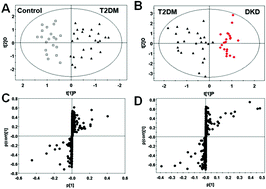当前位置:
X-MOL 学术
›
Mol. Biosyst.
›
论文详情
Our official English website, www.x-mol.net, welcomes your feedback! (Note: you will need to create a separate account there.)
Metabolomics reveal mitochondrial and fatty acid metabolism disorders that contribute to the development of DKD in T2DM patients
Molecular BioSystems Pub Date : 2017-09-14 00:00:00 , DOI: 10.1039/c7mb00167c Ling Li 1, 2, 3, 4, 5 , Chengshi Wang 3, 5, 6, 7 , Hongliu Yang 1, 2, 3, 4, 5 , Shuyun Liu 3, 5, 6, 7 , Yanrong Lu 3, 5, 6, 7 , Ping Fu 1, 2, 3, 4, 5 , Jingping Liu 3, 5, 6, 7
Molecular BioSystems Pub Date : 2017-09-14 00:00:00 , DOI: 10.1039/c7mb00167c Ling Li 1, 2, 3, 4, 5 , Chengshi Wang 3, 5, 6, 7 , Hongliu Yang 1, 2, 3, 4, 5 , Shuyun Liu 3, 5, 6, 7 , Yanrong Lu 3, 5, 6, 7 , Ping Fu 1, 2, 3, 4, 5 , Jingping Liu 3, 5, 6, 7
Affiliation

|
Diabetic kidney disease (DKD) is the leading cause of ESRD; however, early intervention can greatly prevent the progression of DKD; thus, sensitive biomarkers for DKD are still required. This study was aimed at the identification of potential biomarkers and revelation of underlying pathways in DKD patients by non-targeted metabolomics. Gas chromatography-mass spectrometry was used to analyze urine obtained from the control and type 2 diabetes mellitus (T2DM) and DKD patients, and the renal histological changes in DKD patients were assessed. The DKD group showed increased level of uric acid, 1,5-anhydroglucitol, hippuric acid, stearic acid, and palmitic acid and reduced level of uracil, glycine, aconitic acid, isocitric acid, 4-hydroxybutyrate, 2-deoxyerythritol, and glycolic acid as compared to the control and T2DM groups. Further analysis indicated that many of the changed metabolites were involved in mitochondrial and fatty acid (FA) metabolism, and combined mitochondrial and FA metabolites showed better diagnosis values for DKD. Histological results confirmed that renal expression of key proteins was reduced in DKD patients with respect to mitochondrial biogenesis (PGC-1α, p-AMPK) and FA oxidation (PPAR-α, CPT-1) as compared to that in the control and T2DM groups. This study highlighted that both mitochondrial and FA metabolism were disturbed in DKD, and thus, they could serve as combined biomarkers for the prediction of DKD.
中文翻译:

代谢组学揭示了线粒体和脂肪酸代谢紊乱,这些疾病有助于T2DM患者DKD的发展
糖尿病肾病(DKD)是ESRD的主要原因。但是,早期干预可以极大地阻止DKD的发展。因此,仍然需要用于DKD的敏感生物标记。这项研究的目的是通过非靶向代谢组学鉴定DKD患者的潜在生物标志物和潜在途径。气相色谱-质谱法分析了对照组和2型糖尿病(T2DM)和DKD患者的尿液,并评估了DKD患者的肾脏组织学变化。DKD组显示尿酸,1,5-脱水葡萄糖醇,马尿酸,硬脂酸和棕榈酸水平升高,尿嘧啶,甘氨酸,乌头酸,异柠檬酸,4-羟基丁酸酯,2-脱氧赤藓糖醇和乙醇酸水平降低与对照组和T2DM组相比。进一步的分析表明,许多改变的代谢物都参与了线粒体和脂肪酸(FA)的代谢,并且线粒体和FA代谢物的结合对DKD的诊断价值更高。组织学结果证实,与对照组和T2DM组相比,DKD患者的线粒体生物生成(PGC-1α,p-AMPK)和FA氧化(PPAR-α,CPT-1)肾关键蛋白表达降低。 。这项研究强调,线粒体和FA代谢在DKD中均受到干扰,因此,它们可作为联合生物标记物用于DKD的预测。组织学结果证实,与对照组和T2DM组相比,DKD患者的线粒体生物生成(PGC-1α,p-AMPK)和FA氧化(PPAR-α,CPT-1)肾关键蛋白表达降低。 。这项研究强调,线粒体和FA代谢在DKD中均受到干扰,因此,它们可作为联合生物标记物用于DKD的预测。组织学结果证实,与对照组和T2DM组相比,DKD患者的线粒体生物合成(PGC-1α,p-AMPK)和FA氧化(PPAR-α,CPT-1)肾关键蛋白表达降低。 。这项研究强调,线粒体和FA代谢在DKD中均受到干扰,因此,它们可作为联合生物标记物用于DKD的预测。
更新日期:2017-10-25
中文翻译:

代谢组学揭示了线粒体和脂肪酸代谢紊乱,这些疾病有助于T2DM患者DKD的发展
糖尿病肾病(DKD)是ESRD的主要原因。但是,早期干预可以极大地阻止DKD的发展。因此,仍然需要用于DKD的敏感生物标记。这项研究的目的是通过非靶向代谢组学鉴定DKD患者的潜在生物标志物和潜在途径。气相色谱-质谱法分析了对照组和2型糖尿病(T2DM)和DKD患者的尿液,并评估了DKD患者的肾脏组织学变化。DKD组显示尿酸,1,5-脱水葡萄糖醇,马尿酸,硬脂酸和棕榈酸水平升高,尿嘧啶,甘氨酸,乌头酸,异柠檬酸,4-羟基丁酸酯,2-脱氧赤藓糖醇和乙醇酸水平降低与对照组和T2DM组相比。进一步的分析表明,许多改变的代谢物都参与了线粒体和脂肪酸(FA)的代谢,并且线粒体和FA代谢物的结合对DKD的诊断价值更高。组织学结果证实,与对照组和T2DM组相比,DKD患者的线粒体生物生成(PGC-1α,p-AMPK)和FA氧化(PPAR-α,CPT-1)肾关键蛋白表达降低。 。这项研究强调,线粒体和FA代谢在DKD中均受到干扰,因此,它们可作为联合生物标记物用于DKD的预测。组织学结果证实,与对照组和T2DM组相比,DKD患者的线粒体生物生成(PGC-1α,p-AMPK)和FA氧化(PPAR-α,CPT-1)肾关键蛋白表达降低。 。这项研究强调,线粒体和FA代谢在DKD中均受到干扰,因此,它们可作为联合生物标记物用于DKD的预测。组织学结果证实,与对照组和T2DM组相比,DKD患者的线粒体生物合成(PGC-1α,p-AMPK)和FA氧化(PPAR-α,CPT-1)肾关键蛋白表达降低。 。这项研究强调,线粒体和FA代谢在DKD中均受到干扰,因此,它们可作为联合生物标记物用于DKD的预测。



























 京公网安备 11010802027423号
京公网安备 11010802027423号